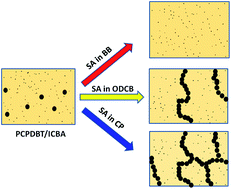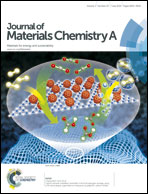Control of morphology and function of low band gap polymer–bis-fullerene mixed heterojunctions in organic photovoltaics with selective solvent vapor annealing†
Abstract
Replacing PCBM with a bis-adduct fullerene (i.e. ICBA) has been reported to significantly improve the open circuit voltage (VOC) and power conversion efficiency (PCE) in P3HT bulk heterojunctions. However, for the most promising low band-gap polymer (LBP) systems, replacing PCBM with ICBA results in very poor short-circuit current (JSC) and PCE although the VOC is significantly improved. Therefore, in this work, we have completed small angle neutron scattering and neutron reflectometry experiments to study the impact of post-deposition solvent annealing (SA) with control of solvent quality on the morphology and performance of LBP–bis-fullerene BHJ photovoltaics. The results show that SA in a solvent that is selective for the LBP results in a depletion of bis-fullerene near the air surface, which limits device performance. SA in a solvent vapor which has similar solubility for polymer and bis-fullerene results in a higher degree of polymer ordering, bis-fullerene phase separation, and segregation of the bis-fullerene to the air surface, which facilitates charge transport and increases power conversion efficiency (PCE) by 100%. The highest degree of polymer ordering combined with significant bis-fullerene phase separation and segregation of bis-fullerene to the air surface is obtained by SA in a solvent vapor that is selective for the bis-fullerene. The resultant morphology increases PCE by 190%. These results indicate that solvent annealing with judicious solvent choice provides a unique tool to tune the morphology of LBP–bis-fullerene BHJ system, providing sufficient polymer ordering, formation of a bis-fullerene pure phase, and segregation of bis-fullerene to the air surface to optimize the morphology of the active layer. Moreover, this process is broadly applicable to improving current “disappointing” LBP–bis-fullerene systems to optimize their morphology and OPV performance post-deposition, including higher VOC and power conversion efficiency.


 Please wait while we load your content...
Please wait while we load your content...